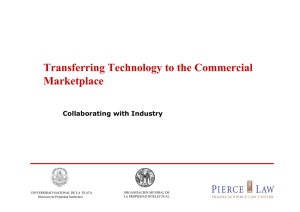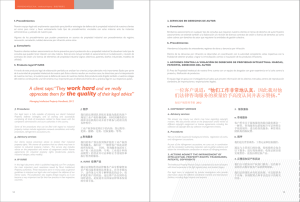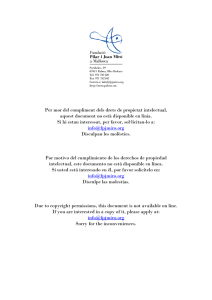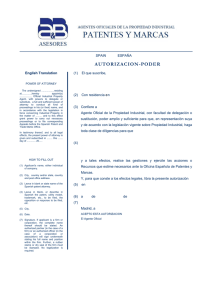Transferring Technology to the Commercial Marketplace The Steps
Anuncio
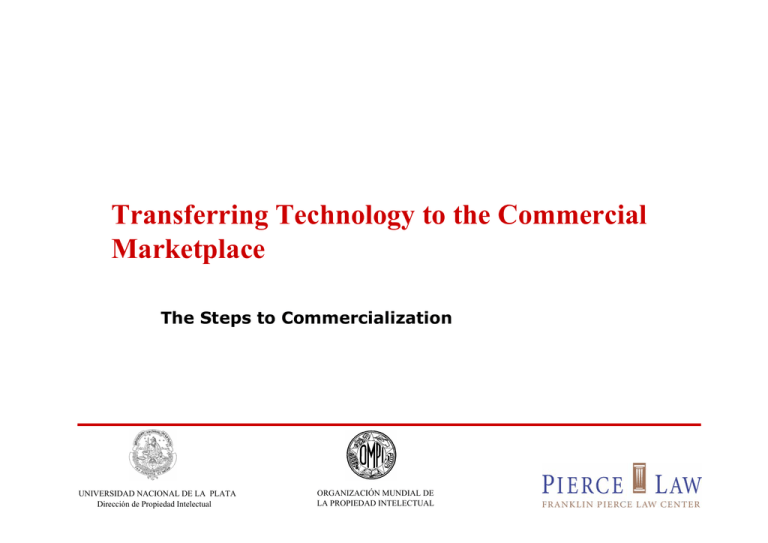
Transferring Technology to the Commercial Marketplace The Steps to Commercialization UNIVERSIDAD NACIONAL DE LA PLATA Dirección de Propiedad Intelectual ORGANIZACIÓN MUNDIAL DE LA PROPIEDAD INTELECTUAL Step 1: Analyzing the Disclosure: Invention Disclosure and Checklist Type of technology • • • Ownership issues • Patent Copyright/Software Biological Materials Identifying true inventors/authors and status when technology developed (required to assign/not required to assign) Prior agreement obligations – who is entitled to licenses Identifying any bars, i.e. prior publication, use of third-party owned intellectual property or other encumbrances that would preclude transfer for commercialization UNIVERSIDAD NACIONAL DE LA PLATA Dirección de Propiedad Intelectual ORGANIZACIÓN MUNDIAL DE LA PROPIEDAD INTELECTUAL Step 2: Meeting with Inventor: Invention Disclosure and Patentability Evaluation Assessing stage of the invention? prototype, proof of concept, in vitro/vivo experiments? If technology patentable, is publication bar anticipated? What is novel about the discovery/potential commercial uses Does inventor know companies that may be licensees? What would the inventor like to do? Start-up possible? Setting reasonable expectations with the inventor as to: • • • Filing patent applications Understanding how to deal with patent attorneys Marketing assistance, if any, expected from the inventor UNIVERSIDAD NACIONAL DE LA PLATA Dirección de Propiedad Intelectual ORGANIZACIÓN MUNDIAL DE LA PROPIEDAD INTELECTUAL Step 3: Protecting the Invention Dangers on the way to patenting • Enthusiastic Inventor discloses to 3rd parties, including colleagues and students • Inventor submits an article for peer review • Following the rules, Inventor discloses the invention to the TTO, but the TTO is careless about handling it • The TTO is not careless, but underestimates honesty of potential licensees UNIVERSIDAD NACIONAL DE LA PLATA Dirección de Propiedad Intelectual ORGANIZACIÓN MUNDIAL DE LA PROPIEDAD INTELECTUAL Step 3.5: Ensuring the Invention is Protected Once Invention enters patent system – patent laws will provide protection against thievery for most part But, if Invention not yet in patent system – 2 possibilities for protection • Trade secret o Protects Invention against misappropriation (theft) • Contract o Protects Invention against misuse by potential licensees UNIVERSIDAD NACIONAL DE LA PLATA Dirección de Propiedad Intelectual ORGANIZACIÓN MUNDIAL DE LA PROPIEDAD INTELECTUAL Step 3.5: Ensuring the Invention is Protected If Invention (before patenting) qualifies a “secret” and is maintained . . . • TTO does o Develop a nondisclosure agreement to cover o Develop a non-confidential summary o Consider filing patent application • TTO does not o Put description of invention on its website o Disclose invention to potential licensees without requiring nondisclosure agreement to be signed UNIVERSIDAD NACIONAL DE LA PLATA Dirección de Propiedad Intelectual ORGANIZACIÓN MUNDIAL DE LA PROPIEDAD INTELECTUAL Step 4: Protecting the Invention During Commercialization Protecting Invention from misuse by contract during licensing period • Simple nondisclosure agreement not sufficient for pre-licensing negotiations • Best practice: use a contract to protect invention as an asset throughout the patenting period o Avoids licensee misuse of invention if secrecy lost inadvertently or invention is published in patenting process o Provides continued protection if leaks occur o Allows Inventor to publish UNIVERSIDAD NACIONAL DE LA PLATA Dirección de Propiedad Intelectual ORGANIZACIÓN MUNDIAL DE LA PROPIEDAD INTELECTUAL Step 4: Protecting the Invention During Commercialization Essential terms of a Pre-Market or Option Agreement • Parties o Authorized signatories • Definition of Invention o May have changed – will need to include patent application, issued patent and patent-owner case or tracking identifier • Reaffirm confidentiality obligations as long as Invention is not publicly known UNIVERSIDAD NACIONAL DE LA PLATA Dirección de Propiedad Intelectual ORGANIZACIÓN MUNDIAL DE LA PROPIEDAD INTELECTUAL Step 4: Protecting the Invention During Commercialization More terms of contract • Permitted uses o Evaluation only o No use in company research o No use for or as commercial product • No express or implied license, except evaluation; no obligation for license relationship on part of parties unless specifically included (see following) • Potential Licensee to make decisions/exercise option within specific time period • Add disclaimers of warranties and representations UNIVERSIDAD NACIONAL DE LA PLATA Dirección de Propiedad Intelectual ORGANIZACIÓN MUNDIAL DE LA PROPIEDAD INTELECTUAL Step 4: Protecting the Invention During Commercialization Limit extent to which invention becomes known. The more people who know it the less likely it will have trade secret protection (remember, in pre-patent stage, no patent protection- so Trade Secret may be only legal protection available) UNIVERSIDAD NACIONAL DE LA PLATA Dirección de Propiedad Intelectual ORGANIZACIÓN MUNDIAL DE LA PROPIEDAD INTELECTUAL Step 4: Protecting the Invention During Commercialization Take effective protective measures • Through education of faculty inventors & administrators • Provide nondisclosure agreement to inventor – just in case he/she contacts a company • Add non-disclosure provisions covering inventions to industrial research contracts • Release only non-confidential information for general/website marketing • Release enabling description of Invention to third party only under nondisclosure UNIVERSIDAD NACIONAL DE LA PLATA Dirección de Propiedad Intelectual ORGANIZACIÓN MUNDIAL DE LA PROPIEDAD INTELECTUAL Step 5: Whether to Patent: Patentability Evaluation Assess patentability through literature search for prior art Get recommendation/cost commitment from outside patent attorney If dedicated patent firms (or attorney that the TTO or inventor prefer to use), involve them early in the process UNIVERSIDAD NACIONAL DE LA PLATA Dirección de Propiedad Intelectual ORGANIZACIÓN MUNDIAL DE LA PROPIEDAD INTELECTUAL Step 5: Whether to Patent: Product Characteristic & Market Potential Assessing commercial potential using a number of factors including • • • • • • • • Highest and best use Weighing advantages over existing technologies If new, weighing the barriers to market Assessing the strength of competitors Estimating market size Determining strength of patent/can its use be policed? If time and resources can do market study If patent committee involved, send to patent committee with findings/recommendations UNIVERSIDAD NACIONAL DE LA PLATA Dirección de Propiedad Intelectual ORGANIZACIÓN MUNDIAL DE LA PROPIEDAD INTELECTUAL Step 5.5: Patenting: Use Market Potential Evaluations (unless building inventory) Determine where to file based on early “best use” assessment File cheapest (PCT) if possible If possible, respond to early licensee preferences for geographic protection Make decision: Who will prepare application and file? • University/research center • Licensee • Other ? UNIVERSIDAD NACIONAL DE LA PLATA Dirección de Propiedad Intelectual ORGANIZACIÓN MUNDIAL DE LA PROPIEDAD INTELECTUAL Step 5.5: Patenting Finding Patent Funding • Institutional budget – annual set aside based on budget forecast • “Pay as you go”/funds spent dependent upon royalties received and % retained in “royalty account” • Licensee commits to paying patent costs • Department, Lab, Center pays for its own patent filings • Industry research consortia members commit % of research funding to fund patenting UNIVERSIDAD NACIONAL DE LA PLATA Dirección de Propiedad Intelectual ORGANIZACIÓN MUNDIAL DE LA PROPIEDAD INTELECTUAL Step 5.5: Patenting Finding Patent Funding • Outside “captive” fund pays (may be a regional or national fund) • Any venture fund pays costs for selected candidates • Patent Fund “Start-up” Grant (most likely term limited) • Angel/inventor investors (for spinouts) UNIVERSIDAD NACIONAL DE LA PLATA Dirección de Propiedad Intelectual ORGANIZACIÓN MUNDIAL DE LA PROPIEDAD INTELECTUAL Transferring Technology to the Commercial Marketplace All About Marketing UNIVERSIDAD NACIONAL DE LA PLATA Dirección de Propiedad Intelectual ORGANIZACIÓN MUNDIAL DE LA PROPIEDAD INTELECTUAL Step 6: Getting Ready to Market Prepare non-confidential abstract Follow-up leads from inventor or consultants Is outside marketing expert needed – determine early as marketing reports take time Decide on best marketing strategy • Targeted marketing - focus on 1-3 companies • Shotgun approach – mass mailings, technology databases • Timed approach – beginning with targets and broaden if no show of interest by a certain date UNIVERSIDAD NACIONAL DE LA PLATA Dirección de Propiedad Intelectual ORGANIZACIÓN MUNDIAL DE LA PROPIEDAD INTELECTUAL Step 6: Getting Ready to Market Prepare marketing information package including patent application if ready or filed • Describe research • Have marketing tools in place o Rolodex, invention abstract, patent search, corporate directories, trade journals, database access, NDAs, names of commercial assessment firms, if needed. UNIVERSIDAD NACIONAL DE LA PLATA Dirección de Propiedad Intelectual ORGANIZACIÓN MUNDIAL DE LA PROPIEDAD INTELECTUAL Step 7: Marketing: Marketing & Product Profiles, Company Comments Maintain constant contact with prospects Set up inventor/prospect meetings; send inventor out on licensee prospect visits (not alone) Make sure all necessary information is accessible and user friendly • • • • • Results of patent search Test data Copies of publications Manuscripts Patent application Have “basic terms” prepared on paper including royalty terms and supporting backup UNIVERSIDAD NACIONAL DE LA PLATA Dirección de Propiedad Intelectual ORGANIZACIÓN MUNDIAL DE LA PROPIEDAD INTELECTUAL Step 7: Marketing the Technology Expect difficulty in marketing to existing companies. What you can expect to hear: • • • • • The “science” is unproven – no one believes it The idea is too new – the market is unproven Development costs too high and too risky We have no R&D capability that can handle it We are already over-committed on research and development; it competes with our own products • If we didn’t invent it, we don’t want it Essential to find a champion within the company – VP New Products, VP Business Development, leading company scientist, or higher UNIVERSIDAD NACIONAL DE LA PLATA Dirección de Propiedad Intelectual ORGANIZACIÓN MUNDIAL DE LA PROPIEDAD INTELECTUAL Step 8: Negotiating the Royalties “The licensee determines the royalty by agreeing to pay it!” The Licensee and Licensor will both arrive at an acceptable royalty range. • The licensee will use factors such as o o o o o Value of licensed product to end customer Cost of development Dynamics of the marketplace (how robust is it) Competition Its own financial forecasts UNIVERSIDAD NACIONAL DE LA PLATA Dirección de Propiedad Intelectual ORGANIZACIÓN MUNDIAL DE LA PROPIEDAD INTELECTUAL Step 8: Negotiating the Royalties The licensor will use factors such as • The number/kind of IP assets licensed (or bundled) • The scope of the license rights o o o o Exclusive or non-exclusive Geographical area covered Field of use License term • Commercial potential • R&D to be carried out • Barriers to the marketplace UNIVERSIDAD NACIONAL DE LA PLATA Dirección de Propiedad Intelectual ORGANIZACIÓN MUNDIAL DE LA PROPIEDAD INTELECTUAL Step 8: Negotiating the Royalties Walking away • Each party decides its “walk away” price Bargaining begins . . . . but, all forecasts are hypothetical Factors that may make a difference in “price” • • • • • • Importance of licensed technology to final product Type of product and how unique it is Typical profitability of the type of product Strength and “reach” of the IP Whether blocking IP requires additional licenses Development cost & time to market UNIVERSIDAD NACIONAL DE LA PLATA Dirección de Propiedad Intelectual ORGANIZACIÓN MUNDIAL DE LA PROPIEDAD INTELECTUAL Step 8: Negotiating the Royalties Overall “business” expertise needed to negotiate royalties • Knowledge of product development, manufacturing process • Knowledge of markets • Knowledge of pricing for comparable technologies UNIVERSIDAD NACIONAL DE LA PLATA Dirección de Propiedad Intelectual ORGANIZACIÓN MUNDIAL DE LA PROPIEDAD INTELECTUAL Step 8: Sample Royalty Ranges (MIT) License without equity • License issue fee: $10,000-$200,000 • Annual license fee (minimum royalties): $20,000>$200,000re • Milestone payments if applicable: $50,000>$1,000,000 (Upon FDA approval) • Running royalties: 0.5% - 7% (or higher for software and drugs) UNIVERSIDAD NACIONAL DE LA PLATA Dirección de Propiedad Intelectual ORGANIZACIÓN MUNDIAL DE LA PROPIEDAD INTELECTUAL Step 9: Closing the Deal Control drafting of the license agreement Make sure you have authority to commit and so does the party across the table Make sure the inventor knows the deal – document it Make sure all stakeholders understand the deal and have the same expectations UNIVERSIDAD NACIONAL DE LA PLATA Dirección de Propiedad Intelectual ORGANIZACIÓN MUNDIAL DE LA PROPIEDAD INTELECTUAL Step 10: Follow Through: License Profile Get signed agreement Complete license file Place “trigger” dates into database • • • • Sending notices Sending invoices Due diligence reports due Royalty reports due Flag any encumbrances in the license • • • Improvements licensed First option to fund related research Requirement to include updates to software, new applications etc. UNIVERSIDAD NACIONAL DE LA PLATA Dirección de Propiedad Intelectual ORGANIZACIÓN MUNDIAL DE LA PROPIEDAD INTELECTUAL Alternative Commercialization Strategies Delaying the deal through use of the Option* • Usually option is exclusive for a limited period of time (you are taking the patent application/patent off the market) • Prospective licensee/optionee pays patent costs and modest fee • Optionee agrees to confidentiality • May fund research if needed to “prove” invention • Optionee must exercise option by date certain or terminate it (avoid the open-option dilemma) UNIVERSIDAD NACIONAL DE LA PLATA Dirección de Propiedad Intelectual ORGANIZACIÓN MUNDIAL DE LA PROPIEDAD INTELECTUAL Alternative Commercialization Strategies Licensing Trade Secrets • First step: Analyze disclosure for trade secret properties (U.S. requirements) o o o o Non-public information Owned by employer Has economic value Intent to maintain in secrecy UNIVERSIDAD NACIONAL DE LA PLATA Dirección de Propiedad Intelectual ORGANIZACIÓN MUNDIAL DE LA PROPIEDAD INTELECTUAL Alternative Commercialization Strategies Licensing Trade Secrets • • • • Second step: Define it with specificity Third step: Disclose only under non-disclosure agreement Fourth step: Consider step-down license if information is known Fifth step: Set up management system UNIVERSIDAD NACIONAL DE LA PLATA Dirección de Propiedad Intelectual ORGANIZACIÓN MUNDIAL DE LA PROPIEDAD INTELECTUAL Alternative Commercialization Strategies Licensing Know-How – A few pointers: • Must be carefully defined with rights retained, if needed • Must assign a value to it (needs to qualify as “consideration”) UNIVERSIDAD NACIONAL DE LA PLATA Dirección de Propiedad Intelectual ORGANIZACIÓN MUNDIAL DE LA PROPIEDAD INTELECTUAL Alternative Commercialization Strategies Licensing Know-How – A few pointers: • Combining with patent license takes planning o Pluses: Adds value to patent license and may extend life of the license beyond the patent term o Minuses: If patent license terminated or breached is know-how license also terminated or breached and viceversa? • Best practice: Combine a non-exclusive know- how license with an exclusive patent license UNIVERSIDAD NACIONAL DE LA PLATA Dirección de Propiedad Intelectual ORGANIZACIÓN MUNDIAL DE LA PROPIEDAD INTELECTUAL Alternative Commercialization Strategies Licensing Biological Materials – A few pointers: • Exclusive license removes them from institutional use unless continuing research rights are reserved • Must reserve rights for research/experimentation if publishing or journals will not accept article • Non-exclusive licenses may be enough although will be at reduced royalty • Consider licensing for research but require additional license for commercial use UNIVERSIDAD NACIONAL DE LA PLATA Dirección de Propiedad Intelectual ORGANIZACIÓN MUNDIAL DE LA PROPIEDAD INTELECTUAL Transferring Technology to the Commercial Marketplace Collaborating with Industry UNIVERSIDAD NACIONAL DE LA PLATA Dirección de Propiedad Intelectual ORGANIZACIÓN MUNDIAL DE LA PROPIEDAD INTELECTUAL University-Industry Relationships in the U.S.: The Many Options Single sponsor/single SOW research projects Consortia (many companies funding together) Cooperative Research (government funded with company) Master/Umbrella Agreements Long-term Alliance Agreements Joint Studies/no cost Visiting Scientist Exchange Agreements Material Transfer Agreements UNIVERSIDAD NACIONAL DE LA PLATA Dirección de Propiedad Intelectual ORGANIZACIÓN MUNDIAL DE LA PROPIEDAD INTELECTUAL Standardized Terms Generally Found Inventions are owned according to U.S. patent law • Mine, yours, ours • No accounting or licensing approvals required where patents are jointly owned through co-inventorship • Invention ownership is not assigned to industry: fairly universal rejection by universities of “we paid for it so we own it” philosophy Same with copyrights and all other IP Publication delays only for sponsor confidential information and potential patents • Usually a 90 day limit UNIVERSIDAD NACIONAL DE LA PLATA Dirección de Propiedad Intelectual ORGANIZACIÓN MUNDIAL DE LA PROPIEDAD INTELECTUAL More Standardized Terms Research sponsors do receive license grants • Most common: Royalty-free, non-exclusive license without right to sublicense; option to negotiate a royalty-bearing exclusive license • Uncommon: Royalty-bearing license to be negotiated • Middle ground: Royalty-free, non-exclusive for non-commercial purposes Royalty rates • Most common: Fair and reasonable to be negotiated • Uncommon: Pre-set in research agreement • Possible middle ground: Floor > Ceiling set in research agreement UNIVERSIDAD NACIONAL DE LA PLATA Dirección de Propiedad Intelectual ORGANIZACIÓN MUNDIAL DE LA PROPIEDAD INTELECTUAL And, More Standardized Terms Who Files? • Common: University files through patent counsel of choice • Not quite so common: University permits industry sponsor to file provided university has right of review and comment • Issue: Who is the client? UNIVERSIDAD NACIONAL DE LA PLATA Dirección de Propiedad Intelectual ORGANIZACIÓN MUNDIAL DE LA PROPIEDAD INTELECTUAL And, More Standardized Terms Payment of patent costs • Most common: Sponsor/licensee to pay if license is exclusive • Uncommon: University undertakes obligation to file and always pays • Middle ground: Sponsor to pay to ensure patent application is filed; otherwise discretionary with university UNIVERSIDAD NACIONAL DE LA PLATA Dirección de Propiedad Intelectual ORGANIZACIÓN MUNDIAL DE LA PROPIEDAD INTELECTUAL Identifying Clauses That Play a Role in Technology Transfer The parties (who will be the “licensee” if IP is developed) Typical clauses involving intellectual property rights/obligations • Definitions of “invention” and other IP • Requirement to disclose • Patent filing obligations; foreign filing elections and who pays UNIVERSIDAD NACIONAL DE LA PLATA Dirección de Propiedad Intelectual ORGANIZACIÓN MUNDIAL DE LA PROPIEDAD INTELECTUAL Identifying Clauses That Play a Role in Technology Transfer • Typical clauses involving intellectual property rights/obligations • License rights- patents/copyrights/software/trp o Vesting under research contract (“hereby grants” vs. “agrees to grant”) o Option periods o License terms • Background rights • IP warranties, representations UNIVERSIDAD NACIONAL DE LA PLATA Dirección de Propiedad Intelectual ORGANIZACIÓN MUNDIAL DE LA PROPIEDAD INTELECTUAL The Background Rights Dilemma Background rights – rights to university’s pre-existing, concurrently developed and in some cases “to be developed” IP outside of the scope of the research program. Typical clause requires university to give/license the sponsoring company rights to use any other IP owned by the university that is necessary for/useful for practicing inventions/copyrights or all research results developed during the project. Right is usually open-ended – no time limit on the obligation or exercise of it UNIVERSIDAD NACIONAL DE LA PLATA Dirección de Propiedad Intelectual ORGANIZACIÓN MUNDIAL DE LA PROPIEDAD INTELECTUAL The Problem with Background Rights: A Clearer View Impossible to speculate what university IP will be encumbered because: • Invention to which background rights are tied hasn’t been made yet • Impossible to know how the sponsor may at some future time use an invention, copyright or other research result Provides industry with entitlement to unfunded IP Ties up IP developed by investigator who never took sponsor funding –diminishes the rights/expectations of unsuspecting inventor UNIVERSIDAD NACIONAL DE LA PLATA Dirección de Propiedad Intelectual ORGANIZACIÓN MUNDIAL DE LA PROPIEDAD INTELECTUAL The Problem with Background Rights: A Clearer View Guts university tech transfer program because background is not licensed for benefit of the public (but is used defensively for benefit of a single company). Requires collateral IP (if identifiable) to be put “on hold” Impacts future sponsored research. One company’s background is anther company’s reason to sponsor UNIVERSIDAD NACIONAL DE LA PLATA Dirección de Propiedad Intelectual ORGANIZACIÓN MUNDIAL DE LA PROPIEDAD INTELECTUAL Crawling Out of the Background Rights Dilemma Limit to inventions of named research team – not entire university Limit to “required” for commercialization of licensed inventions – not “useful” for commercialization of research results Limit to “extent university has right to license” Put time limitation on – e.g. inventions made one year after termination of research contract Require royalties to be paid; no consideration for royaltyfree UNIVERSIDAD NACIONAL DE LA PLATA Dirección de Propiedad Intelectual ORGANIZACIÓN MUNDIAL DE LA PROPIEDAD INTELECTUAL
